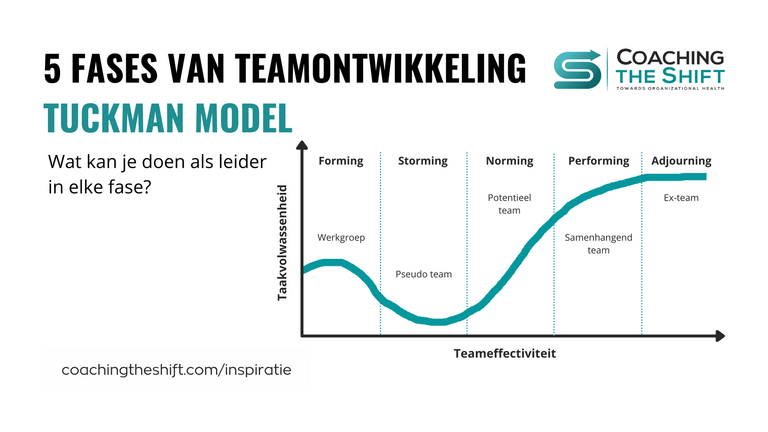5 Stages of Team Development – Tuckman's Model
Throughout a team's lifecycle, not only does individual effectiveness improve, but also the collaboration as a team. This requires several steps where team members open up to each other in order to achieve shared goals more effectively. Tuckman's model defines this process as 5 phases of team development. From forming to performing and even adjourning! What do the different stages mean, and how do you handle them as a leader or team coach?
- The Tuckman Team Development Model
- 5 Phases of Team Development According to Tuckman
- 1) Forming
- 2) Storming
- 3) Norming
- 4) Performing
- 5) Adjourning
Which phase of development is your team in? Book a free Team Scan!
The Tuckman Team Development Model
Bruce Tuckman is an American social psychologist, best known for his model on team development and group formation. He defines 5 stages that teams go through to become more effective. The model is also applicable to other groups such as friend groups, sports teams, or therapy groups.
Although Tuckman's model is not an exact science, many leaders recognize the emotions and behaviors in each stage. These stages often organically emerge from internal needs and each requires a different approach to leadership.

5 Phases of Team Development According to Tuckman
As a team works more effectively together, there is a greater focus on results. A short feedback cycle can lead to small improvements in the team's way of working. Teams that regularly reflect often achieve better results. But what does effectiveness as a team mean?
On the one hand, there is the effectiveness of the team as a whole. In other words: how do individual team members work together towards a shared goal? On the other hand, there is effectiveness in tasks. This grows as individual team members gain more experience, but also through collective learning and thus promoting team development.
1) Forming
In the first phase of team development, there is a mix of enthusiasm and uncertainty. On the one hand, employees are excited about new opportunities and discoveries. At the same time, this also leads to many questions and sometimes ambiguity.
During the forming phase, teams need guidance. The most important thing you can do as a leader here is to ensure a clear structure and role division. Does everyone know what the team goals are? Is the team's mission within the organization clear or not?
2) Storming
In the second phase of team development, frustration and anger often arise due to differences in communication or approach among team members. As a leader, you'll focus more on team dynamics and collaboration. What are the strengths and areas for improvement of each team member? How do these personalities work best together?
It's crucial to create an open dialogue where these emotions can be addressed. This requires a safe environment where team members interact respectfully and can communicate without judgment. Tuckman's model focuses on process and control during this phase. In other words, how can we improve the way the team collaborates?
3) Norming
The third phase of team development revolves around agreements and understanding. This means that team members get to know each other better and can align their communication and working methods accordingly. The transformation from individual to team interests occurs here.
In Tuckman's model, the focus during the norming phase is on team result orientation. With interpersonal frustrations and conflicts resolved, the team now functions as a cohesive unit. Attention shifts to team effectiveness and how to enhance it. The team can give open feedback that fosters collective growth, a process known as team learning.
4) Performing
In the fourth and penultimate phase of Tuckman's team development model, we speak of performing teams. At this stage, the team operates within a safe environment built on mutual trust and openness. Increased input and autonomy make team members feel more engaged.
The team is connected to both the mission and each other. There is a positive atmosphere, and problems are resolved collaboratively and respectfully. The short feedback cycle keeps everyone focused on the ultimate goal, which is the group's results.
5) Adjourning
Finally, there's the Adjourning phase, also known as the disbandment of a team. This phase was added later to Tuckman's team development model and occurs when the team's current functioning is significantly altered. Depending on the reason, this stage can bring about a range of emotions. Similar to other changes, there may be uncertainty and sometimes fear. On the other hand, feelings of pride and satisfaction can also emerge!
Adjourning or disbandment can occur for various reasons. For example, the team might have achieved its end goal. Alternatively, it could be a result of changes such as a new leader being appointed or shifts in the team's mission and role within the organization.
However, it's important to recognize that change is a constant. Team composition and collaboration change each time team members leave or new members join. The ability to quickly adapt to new environments is what makes the strongest teams and leaders.
